As a trader navigating the complex seas of the market, imagine harnessing the power of momentum indicators like a skilled sailor catching the perfect wind.
Understanding how to ride the waves of market momentum effectively can be the key to unlocking your trading potential. From selecting the right indicators to managing risk wisely, these top 10 tips will guide you towards mastering the art of momentum trading.
So, are you ready to set sail on this journey towards greater trading success?
Understanding Different Momentum Indicators
When analyzing market momentum, it's essential to grasp the distinct characteristics of various momentum indicators like RSI, MACD, and Stochastic Oscillator. These indicators play a vital role in assessing market trends and momentum strength.
RSI, for instance, helps identify potential trend reversals by indicating overbought or oversold conditions. On the other hand, MACD focuses on trend changes and momentum strength through moving averages analysis. Stochastic Oscillator evaluates momentum by comparing a security's closing price to its price range over a specific period.
Understanding these different indicators is crucial for making informed decisions in the market. Each indicator provides unique insights into market behavior, allowing traders to react effectively to changing conditions and optimize their trading strategies for better outcomes.
Choosing the Right Timeframe for Analysis

Consider your trading style when selecting the timeframe for analysis to optimize signal frequency and reliability. Short-term traders utilizing momentum trading strategies may find 5-minute or 15-minute charts suitable, offering more signals but susceptible to noise.
Conversely, long-term investors may favor daily or weekly charts for more dependable signals despite potentially missing quick opportunities. When deciding on a timeframe, factor in the asset's volatility and historical price movements to align with your strategy and risk tolerance.
Experiment with various timeframes to determine the most effective one for your trading approach. By tailoring your timeframe analysis to suit your trading style, you can enhance the precision and effectiveness of your momentum indicators.
Identifying Overbought and Oversold Conditions
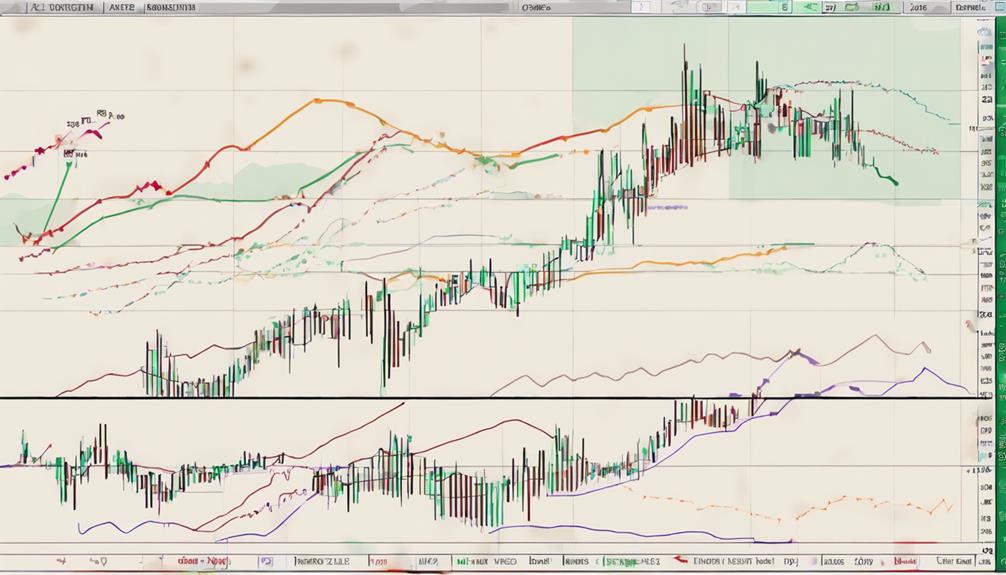
When trading, it's crucial to recognize overbought and oversold levels to make informed decisions. Identifying extremes easily, timing your entry and exit points effectively, and avoiding false signals are key aspects to consider.
Utilizing momentum indicators can help you navigate these conditions and enhance your risk management strategies.
Spotting Extremes Easily
Spotting extremes easily in momentum indicators involves recognizing overbought and oversold conditions through specific threshold levels.
Overbought conditions are typically signaled when the indicator surpasses the -20 level, indicating a potential sell-off ahead.
Conversely, oversold conditions are often identified when the indicator drops below the -80 level, hinting at a possible buying opportunity.
Extreme highs in momentum indicators suggest strong buying momentum and may indicate a continuation of an upward trend. On the other hand, extreme lows point to intense selling pressure and could signal a continuation of a downward trend.
It's advisable to confirm these overbought or oversold conditions with other technical indicators to make well-informed trading decisions.
Timing Entry and Exit
To effectively time your entry and exit in trading, leverage momentum indicators such as the Relative Strength Index (RSI) to pinpoint overbought and oversold conditions.
Overbought conditions, typically above 70 on the RSI, indicate potential sell opportunities as they suggest strong upward momentum that may soon reverse.
On the other hand, oversold conditions, usually below 30 on the RSI, signal potential buy opportunities, suggesting that the price may have dropped too far and could be due for a bounce back up.
Recognizing these overbought and oversold levels on the RSI can aid in making informed trading decisions and capturing price reversals. Utilizing these signals can enhance your ability to enter and exit trades at advantageous moments.
Avoiding False Signals
One must exercise caution in interpreting overbought and oversold conditions to avoid falling prey to false signals in momentum indicators.
- Overbought conditions occur when the momentum indicator reaches above -20, signaling potential selling opportunities.
- Oversold conditions are identified when the momentum indicator drops below -80, indicating potential buying opportunities.
- False signals in momentum indicators can lead to erroneous trading decisions if not confirmed by other technical tools or indicators.
Recognizing the distinction between overbought and oversold levels is crucial for traders as it allows them to anticipate potential reversals in market trends. This understanding enhances the accuracy of momentum indicator signals, forming a solid foundation for effective trading strategies.
Utilizing Divergence for Confirmation
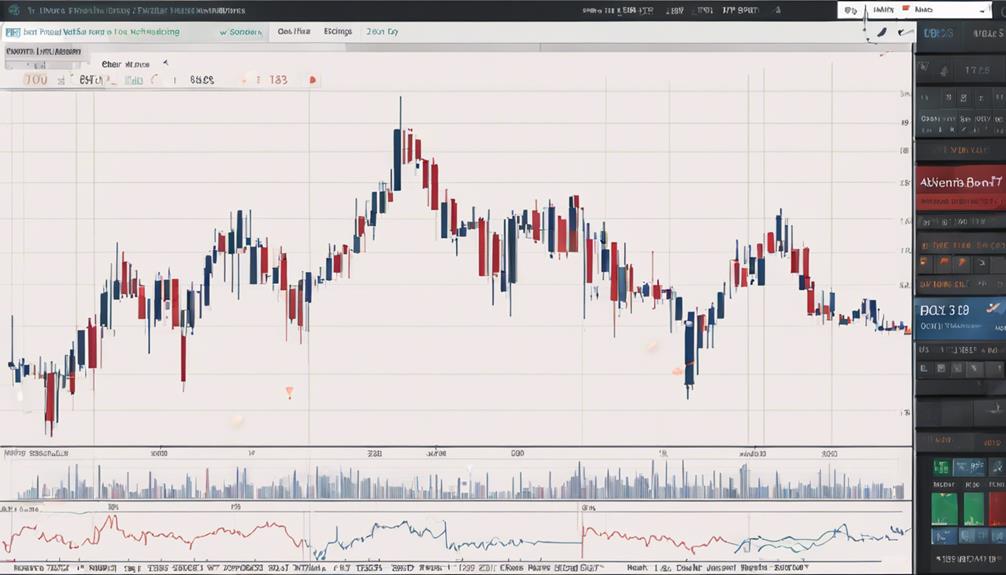
When analyzing price movements, incorporating divergence in momentum indicators serves as a valuable tool for confirming potential trend changes.
Divergence occurs when price movement deviates from the indicator's direction, providing traders with essential signals. Bullish divergence suggests possible upward price movements, while bearish divergence hints at potential downward trends. Traders rely on this phenomenon to validate trend reversals or continuations in price direction.
By combining divergence with other technical indicators, traders can enhance the reliability of their trading signals. Understanding how divergence works not only confirms potential trend changes but also improves decision-making in momentum trading strategies.
Embracing divergence as a confirmation tool can significantly impact the accuracy of your trading decisions.
Implementing Moving Averages With Momentum
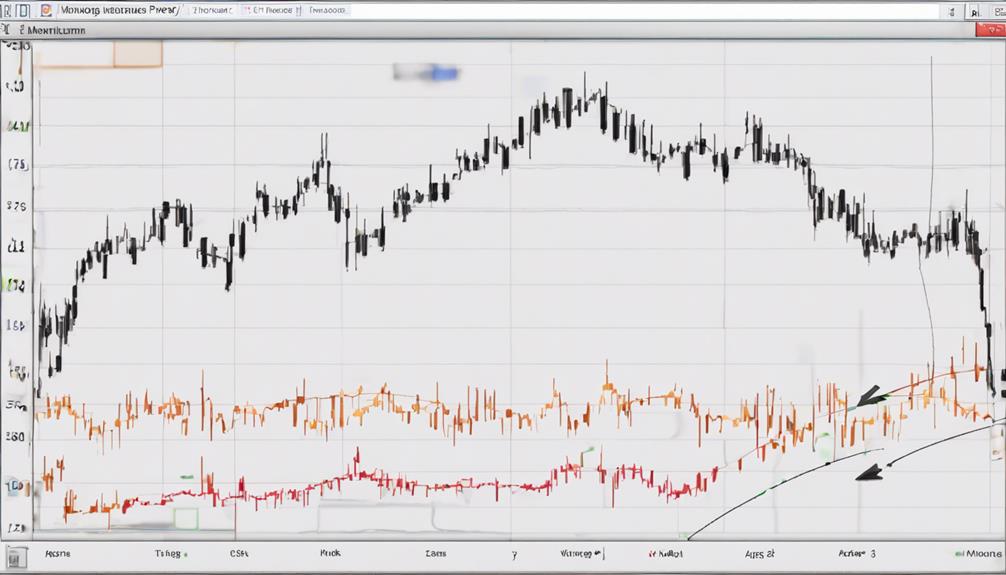
Incorporating moving averages with momentum indicators enhances trend analysis and confirmation in trading strategies. This integration provides a comprehensive view of market trends and potential entry or exit points. Here are some key points to consider:
- Moving averages help smooth out price fluctuations, making trends more visible.
- Momentum indicators such as RSI or MACD can validate the strength of a trend.
- Crossover strategies like the Golden Cross and Death Cross offer clear buy or sell signals based on moving average interactions.
Setting Realistic Profit Targets
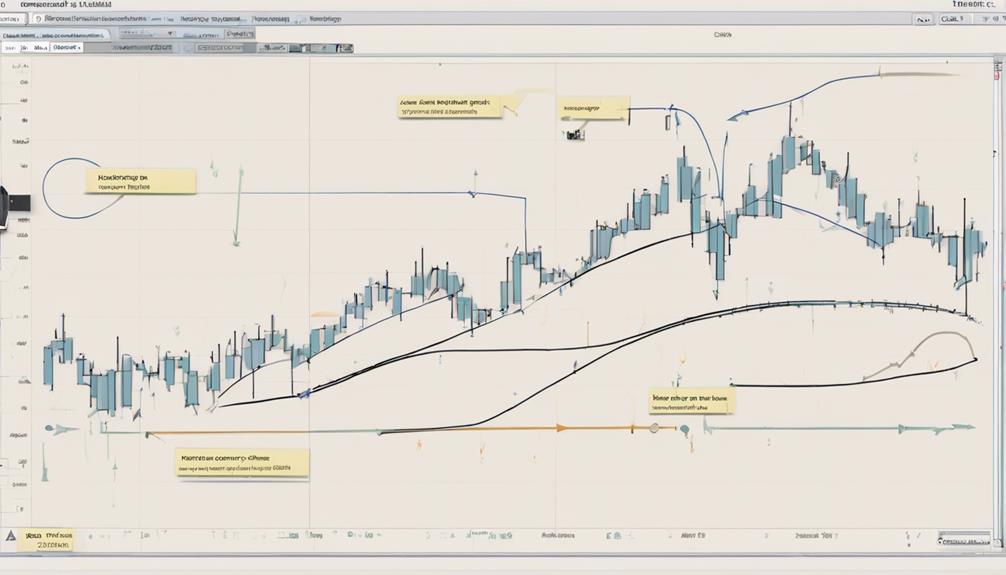
To set realistic profit targets effectively, traders should strategically identify key support and resistance levels through price action analysis. By analyzing these levels, traders can determine points at which the price is likely to encounter barriers or reverse direction, aiding in setting achievable profit targets.
Considering the average true range (ATR) is crucial as it provides insight into the potential price movement, helping traders establish realistic profit goals. Utilizing a risk-reward ratio of at least 1:2 can assist in maintaining a balance between potential gains and losses.
Adapting profit targets to market volatility and adjusting them based on trade duration can optimize trading outcomes. Incorporating trailing stop-loss orders further enhances profit protection and the ability to maximize gains as the trade progresses.
Combining Momentum Indicators for Accuracy
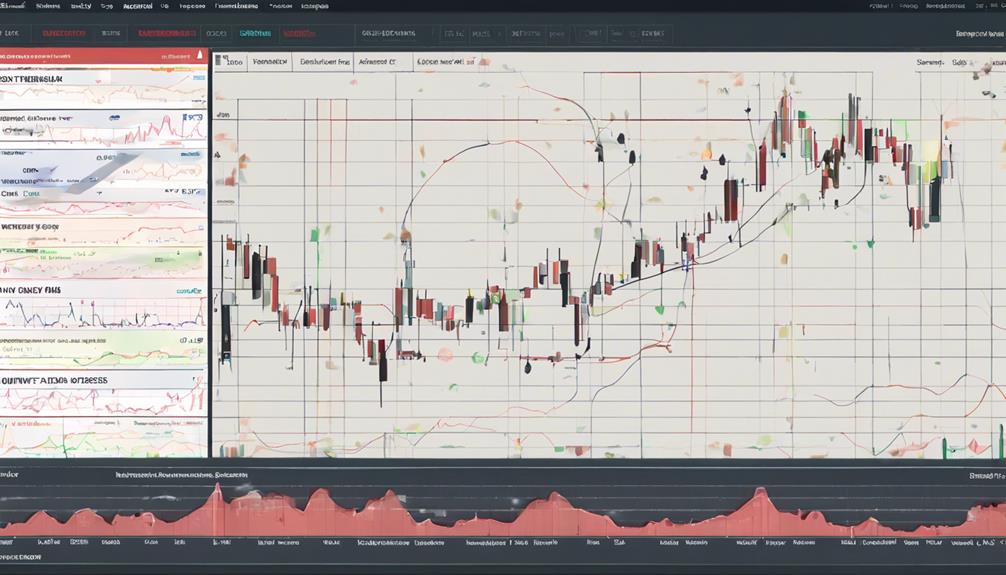
By combining various momentum indicators like RSI, MACD, and Stochastic Oscillator, you can enhance the accuracy of your trend analysis. Diversifying indicators not only confirms market movements but also helps reduce false signals in your trading decisions.
Each indicator offers unique insights into price momentum, strength, and potential reversals, providing a more comprehensive view that can boost your confidence in trade entries and exits.
Indicator Synergy Boosts Accuracy
Enhancing trading accuracy is achieved by combining multiple momentum indicators like RSI, MACD, and Stochastic Oscillator to create a synergy that confirms trend strength and direction. When these indicators work together, traders benefit from increased accuracy and confidence in their decisions.
By cross-referencing signals from different indicators, you can validate trade entries and exits more effectively. This approach minimizes the impact of false signals, leading to improved decision-making and better trade outcomes. In essence, employing indicator synergy helps you identify high-probability trading opportunities, enhancing your overall success in the market.
- Combining multiple momentum indicators like RSI, MACD, and Stochastic Oscillator
- Creating a synergy for confirming trend strength and direction
- Reducing false signals and improving decision-making
Diversify Indicators for Precision
Combining a diverse range of momentum indicators such as RSI, MACD, and Stochastic Oscillator is crucial for enhancing accuracy in trend analysis and confirming price movements. Diversifying indicators provides a more comprehensive view of market momentum, reducing the chances of false signals in trading.
Each momentum indicator brings its own strengths and weaknesses to the table, complementing one another for a more robust analysis. By integrating various momentum indicators, traders can pinpoint more precise entry and exit points in their trading decisions.
This approach not only increases the reliability of signals but also offers a more holistic understanding of the underlying market dynamics, leading to more informed and strategic trading choices.
Managing Risk With Stop Loss Orders

To effectively manage risk in trading, employing stop loss orders is a fundamental practice that assists in limiting potential losses by automatically executing asset sales at predetermined price levels.
When using stop loss orders for risk management, consider the following:
- Protecting Against Adverse Market Movements: Set stop loss orders at specific price points to safeguard your positions.
- Controlling Risk Exposure: Use stop loss orders to manage your risk exposure effectively.
- Avoiding Emotional Decision-making: Implement stop loss orders to stay disciplined and avoid making emotional decisions during market fluctuations.
Monitoring Volume Changes for Confirmation
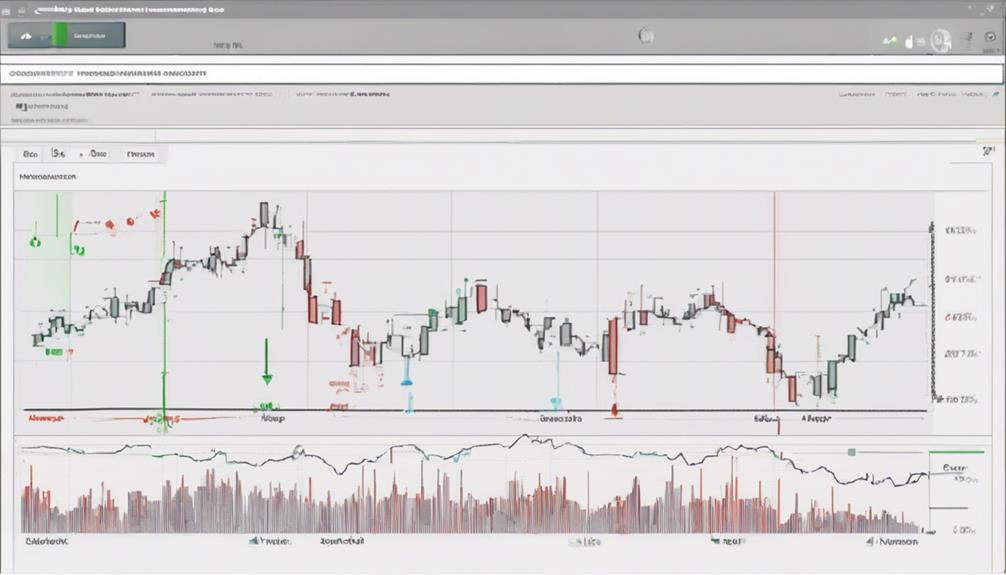
When monitoring volume changes for confirmation, you'll focus on volume as a tool to validate momentum indicators.
Interpreting volume patterns becomes crucial in assessing the strength of price movements and potential trend reversals.
Understanding the importance of volume in conjunction with momentum indicators enhances your ability to make well-informed trading decisions.
Volume as Confirmation
Monitoring volume changes is a crucial aspect that can confirm the strength of a price movement as indicated by a momentum indicator. When analyzing volume for confirmation, consider the following:
- Increasing volume along with a momentum indicator signal suggests a higher probability of a sustainable price trend.
- Volume acts as a validation tool for momentum indicators, indicating the level of market participation in the price movement.
- Divergence between volume and price movement may signal a potential reversal or weakening of the current trend.
Interpreting Volume Patterns
In analyzing volume patterns, observe the fluctuations in market participation to confirm the strength of price movements effectively. Monitoring volume changes is essential for validating the intensity of a trend and verifying price movements.
Increased volume during price uptrends signifies robust buying pressure, indicating a potential continuation of the trend. Conversely, decreasing volume amidst price movements can signal potential reversals. Combining volume analysis with momentum indicators enhances the reliability of trade signals and reduces false indications.
Understanding volume patterns empowers traders to make well-informed decisions by affirming the legitimacy of price movements and trend direction. By paying attention to volume changes alongside price movements and momentum indicators, traders can gain valuable insights into market dynamics and improve their trading strategies.
Importance of Volume
Enhanced trade signal reliability and improved decision-making in trading strategies stem from the crucial role volume plays in confirming the strength of price movements indicated by momentum indicators.
- Monitoring volume changes validates price trend sustainability.
- Increasing volume enhances the reliability of trade entry/exit points.
- Volume spikes indicate market interest, aligning with momentum indicators.
Reviewing and Adjusting Strategy Regularly

Regularly reviewing and adjusting your momentum trading strategy plays a vital role in staying proactive and informed about evolving market dynamics. By analyzing the effectiveness of your strategy, you can pinpoint areas for optimization and improvement, ensuring long-term success in momentum trading.
Monitoring key performance metrics empowers you to make data-driven decisions, enhancing your trading approach. Adapting your strategy to changing market conditions is essential for sustaining profitability and minimizing risks.
Continuous evaluation and fine-tuning based on real-time data maximize profits and keep you ahead in the market. Stay agile and responsive to market shifts by regularly reviewing and adjusting your momentum trading strategy.
What Are Some Advanced Tips for effectively using Momentum Indicators?
When using momentum indicators efficiently, it’s important to look for divergence between price and indicator. Combine multiple indicators for confirmation. Avoid using them in isolation. Use them in conjunction with other technical analysis tools. Be patient and wait for clear signals before making a decision.
Frequently Asked Questions
What Is the Most Accurate Momentum Indicator?
For the most accurate momentum indicator, consider factors like your trading style and preferences. Popular options include RSI, MACD, Stochastic Oscillator, and Williams %R. Choose the one that aligns best with your strategy for reliable signals.
What Are the Best Settings for the Momentum Indicator?
To optimize the Momentum Indicator, consider a 14-day look-back period as a base. Adjusting it can enhance sensitivity to price changes. Shorter periods increase responsiveness, while longer ones offer smoother trends. Experiment with 12 or 20-day settings for varied signals.
What Is the Best Period for Momentum Indicator?
For your momentum indicator, the ideal period generally sits around 14 for a balanced view. Adjusting may heighten sensitivity or smoothness, affecting volatility and lag. Experiment with periods to find what suits your trading style best.
What Is the Best Momentum Strategy?
To excel in momentum trading, focus on combining technical indicators like RSI, MACD, and Stochastic Oscillator. Implement a mix of technical and fundamental analysis for optimal results. Manage risks effectively by setting clear entry and exit points.
Conclusion
You've now equipped yourself with the essential tools and knowledge needed to harness momentum indicators effectively in your trading.
By understanding different indicators, choosing the right timeframe, and managing risk with stop-loss orders, you're ready to navigate the markets with confidence.
Remember to regularly review and adjust your strategy to stay ahead of the game and capitalize on market momentum.
Get ready to ride the wave of success in your trading journey!
